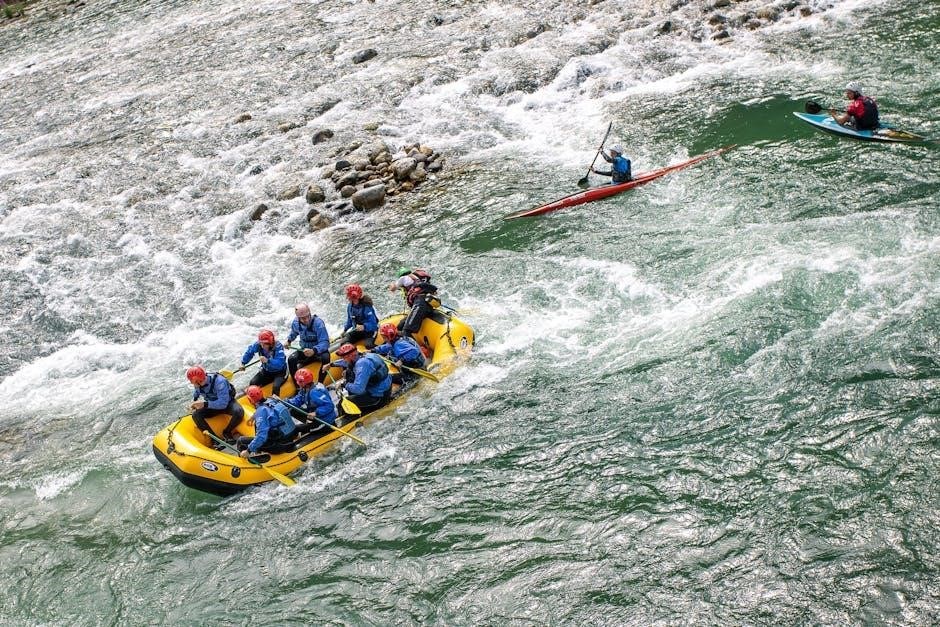Navigating the world of kayaks requires understanding various types, construction materials, and essential features. Consider your intended use – recreational paddling, touring, or something else – to choose wisely.
Kayaking has surged in popularity as an accessible and rewarding outdoor activity, offering a unique perspective on waterways. Whether seeking tranquil recreational paddles, challenging day tours, or multi-day expeditions, a kayak opens doors to exploration and fitness. Before diving in, understanding the basics is crucial for a safe and enjoyable experience. Selecting the right kayak isn’t simply about aesthetics; it’s about matching the boat to your intended use and skill level.
Beginners often gravitate towards recreational kayaks due to their stability and ease of use, while experienced paddlers might prefer the efficiency and tracking of touring or sea kayaks. The advancements in kayak technology, including inflatable options, have broadened accessibility. Furthermore, considering essential accessories like paddles and Personal Flotation Devices (PFDs) is paramount for safety and comfort. This guide will navigate you through the key considerations, empowering you to make an informed decision and embark on your kayaking journey with confidence.
Types of Kayaks: A Comprehensive Overview
The kayak world presents a diverse range of options, each designed for specific purposes and paddling styles. Understanding these distinctions is vital for selecting the right vessel. Recreational kayaks, typically 9 to 12 feet long, prioritize stability and ease of use, making them ideal for beginners and calm waters. Touring/Sea kayaks, ranging from 14 to 18 feet, excel in tracking and efficiency, suited for longer distances and open water.
Sit-on-top kayaks offer self-bailing convenience and are popular for warm weather and fishing, while inflatable kayaks provide portability and storage benefits. Day touring kayaks blend recreational stability with improved efficiency, often at a higher price point. Propulsion methods also vary, encompassing traditional paddle, pedal, and even motorized options. Consider the terrain, duration of trips, and desired level of performance when evaluating these diverse types, ensuring a harmonious match between kayak and paddler.

Recreational Kayaks
Recreational kayaks are the quintessential choice for beginners and casual paddlers seeking leisurely experiences on calm waters. Typically ranging from 9 to 12 feet in length, these kayaks prioritize stability and ease of handling, making them incredibly user-friendly. They’re perfect for exploring lakes, slow-moving rivers, and sheltered bays.
Comfort is key in recreational designs, often featuring wider beams and spacious cockpits for relaxed paddling. The possibilities for propulsion are diverse, encompassing paddle, pedal, and even motorized options. While they may not offer the speed or tracking of touring kayaks, recreational models excel in accessibility and fun. Consider comfort, features, and ease of use when selecting a recreational kayak, focusing on a model that encourages enjoyment and exploration. They are a fantastic entry point into the world of kayaking.
Touring/Sea Kayaks

Touring and sea kayaks are designed for longer expeditions and challenging conditions, offering superior tracking, efficiency, and storage capacity. Typically measuring between 14 and 18 feet in length, their extended waterline provides exceptional glide and directional stability. These kayaks are built for covering distance and handling wind and waves effectively.
Key features include large cockpits for easy entry and exit, supportive backrests for extended comfort, and wide widths for enhanced stability. They often incorporate multiple hatches for secure storage of gear, essential for multi-day trips. Day touring kayaks, a subset of this category, offer a balance between recreational ease and touring performance, often at a higher price point. If you envision embarking on extended paddling adventures or exploring coastal waters, a touring or sea kayak is an excellent investment.
Sit-on-Top Kayaks
Sit-on-top kayaks offer a unique and accessible kayaking experience, favored for their stability, self-bailing design, and ease of use. Unlike sit-inside kayaks, paddlers sit on top of the hull, providing a more open and comfortable feel, particularly appealing to beginners. These kayaks are incredibly versatile, suitable for recreational paddling, fishing, and warm-weather adventures.
A significant advantage is the ease of entry and exit, making them ideal for swimming or re-boarding after a capsize. They typically feature scupper holes that allow water to drain, minimizing the risk of swamping. While generally slower and less efficient than sit-inside kayaks, their stability and user-friendliness make them a popular choice. Consider a sit-on-top kayak if you prioritize ease of use, stability, and enjoy paddling in warmer climates or calm waters. They often come with various features tailored for specific activities like fishing.
Inflatable Kayaks
Inflatable kayaks have surged in popularity, offering portability and convenience without sacrificing performance. Constructed from durable PVC or Hypalon materials, these kayaks can be inflated and deflated, making them easy to transport and store – a significant advantage for those with limited space. Modern inflatable kayaks often feature multiple air chambers for enhanced safety and stability.
Despite common misconceptions, many inflatable kayaks are surprisingly robust and capable of handling various water conditions. They are excellent for recreational paddling, calm lakes, and slow-moving rivers. While they may not match the speed or tracking of hard-shell kayaks, advancements in design have significantly improved their performance. Consider an inflatable kayak if portability is a priority, or if you lack storage space. They are a fantastic entry point into kayaking, offering affordability and ease of use.
Kayak Construction and Materials
The construction and materials of a kayak significantly impact its weight, durability, performance, and price. Two primary materials dominate the market: polyethylene and composite materials like fiberglass and carbon fiber. Polyethylene kayaks are renowned for their affordability and impact resistance, making them ideal for beginners and recreational paddlers who may encounter rocks or shallow waters.
Composite kayaks, on the other hand, offer a superior strength-to-weight ratio, resulting in lighter and faster kayaks. Fiberglass provides a good balance of performance and cost, while carbon fiber is the lightest and stiffest, but also the most expensive. The choice depends on your budget and intended use. Consider the trade-offs between durability, weight, and performance when selecting a kayak. Proper care and maintenance are crucial for all materials to ensure longevity.
Polyethylene Kayaks
Polyethylene kayaks are a popular choice, particularly for beginners and recreational paddlers, due to their robust construction and affordability. Manufactured from high-density polyethylene plastic, these kayaks excel in durability, resisting impacts from rocks, sand, and general wear and tear. This makes them exceptionally well-suited for environments where collisions are likely.

However, this durability comes with a trade-off: polyethylene kayaks are generally heavier and less stiff than those made from composite materials. This increased weight can slightly impact speed and maneuverability. Despite this, their affordability and low maintenance requirements make them an excellent entry point into kayaking. They require minimal specialized care and are relatively easy to repair if damaged. Polyethylene kayaks represent a practical and budget-friendly option for enjoying the water.

Composite Kayaks (Fiberglass, Carbon Fiber)
Composite kayaks, crafted from materials like fiberglass and carbon fiber, represent a premium option for serious kayakers prioritizing performance and weight. These materials yield significantly lighter kayaks compared to polyethylene, translating to increased speed, improved maneuverability, and easier transport. The enhanced stiffness of composite construction also contributes to more efficient paddling and better responsiveness.
However, this superior performance comes at a higher price point. Composite kayaks are considerably more expensive than their polyethylene counterparts. Furthermore, they are more susceptible to damage from impacts and require more careful handling and storage. Repairs, while possible, are typically more complex and costly. Despite these considerations, the benefits of reduced weight, increased efficiency, and a refined paddling experience make composite kayaks a favored choice among touring and sea kayakers seeking top-tier performance.

Key Features to Consider
Selecting the right kayak involves careful consideration of several key features that directly impact your paddling experience. Cockpit size and type are crucial; larger cockpits offer easier entry and exit, while smaller ones provide a more secure fit for rolling maneuvers. Kayak length and width significantly influence performance – longer, narrower kayaks are faster and track straighter, while shorter, wider kayaks are more stable and maneuverable.
Crucially, assess the weight capacity and ensure it comfortably accommodates your body weight plus any gear you plan to carry. Stability and storage options are also vital, particularly for beginners or those planning longer trips. Consider features like adjustable footrests, padded seats, and bulkheads for added comfort and practicality. Ultimately, prioritizing these features will ensure you choose a kayak that aligns with your paddling style and intended use, maximizing enjoyment on the water.

Cockpit Size and Type
The cockpit is the opening you sit in to operate the kayak, and its size and type are fundamental to comfort and performance. Larger cockpits facilitate easier entry and exit, particularly beneficial for beginners or those with limited flexibility. They also offer more room for maneuvering and are often preferred for recreational paddling. Conversely, smaller cockpits provide a snugger fit, enhancing control and making techniques like rolling easier to execute;
Sit-in kayaks typically feature molded cockpits, while sit-on-top kayaks, as the name suggests, have open decks. Consider your skill level and intended use when choosing. A larger cockpit might be ideal for leisurely paddling, while a smaller, more fitted cockpit is preferable for touring or more advanced techniques. Ensure the cockpit comfortably accommodates your hips and legs for optimal control and a secure paddling experience.
Kayak Length and Width: Impact on Performance
Kayak length and width significantly influence performance characteristics. Longer kayaks (12-18 feet) generally track straighter and maintain speed more efficiently, making them ideal for touring and covering long distances. However, they can be less maneuverable. Shorter kayaks (9-12 feet) are more agile and easier to turn, perfect for recreational paddling and navigating tight spaces, but sacrifice some speed and tracking.
Width also plays a crucial role. Wider kayaks offer greater stability, making them excellent for beginners or those paddling in choppy waters. Narrower kayaks are faster and more efficient but require more skill to maintain balance. A wider beam enhances stability, while a narrower beam reduces drag. Consider your skill level, intended paddling environment, and desired performance characteristics when selecting the appropriate length and width for your needs.

Weight Capacity and Your Body Weight
Understanding a kayak’s weight capacity is paramount for safety and performance. This specification indicates the maximum weight the kayak can safely accommodate, including your body weight plus all gear – paddles, PFD, dry bags, and any other equipment. Exceeding the weight limit compromises stability, maneuverability, and can even lead to capsizing.
Always choose a kayak with a weight capacity that comfortably exceeds your total weight. A good rule of thumb is to add at least 25-50 pounds to your weight to account for gear. Consider future needs; will you be carrying extra equipment on certain trips? It’s better to have a kayak with a higher capacity than one that’s maxed out. Ignoring this crucial factor can result in a less enjoyable and potentially dangerous kayaking experience. Prioritize safety and choose wisely!
Understanding Kayak Dimensions and Their Impact
Kayak dimensions – length and width – significantly influence performance characteristics. Longer kayaks generally track straighter and maintain speed more efficiently, making them ideal for touring and covering distance. However, they can be less maneuverable in tight spaces. Shorter kayaks excel in agility and responsiveness, perfect for recreational paddling and navigating rivers or narrow waterways.
Width impacts stability; wider kayaks offer greater stability, beneficial for beginners or those paddling in choppy waters. Narrower kayaks are faster and more efficient but require more skill to maintain balance. The kayak’s hull shape also plays a role – flat bottoms provide stability, while V-shaped hulls enhance tracking and speed. Carefully consider your paddling style, intended environment, and skill level when evaluating these dimensions to find the best fit for your needs.
Kayak Pricing: What to Expect
Kayak prices vary considerably based on type, material, features, and brand. Recreational kayaks typically range from $300 to $800, offering affordability for casual paddlers. Sit-on-top kayaks generally fall within the $400 to $1,000 range, depending on features and construction. Touring or sea kayaks, built for performance and durability, can cost between $800 and $2,000 or more.
Inflatable kayaks present a budget-friendly option, starting around $200 and reaching up to $600. Composite kayaks (fiberglass or carbon fiber) are the most expensive, often exceeding $1,500 due to their lightweight and high-performance characteristics. Remember to factor in the cost of essential accessories – paddles, PFDs, and transport solutions – which can add another $200 to $500 to your overall investment. Day touring kayaks often have a higher price point than recreational models.
Essential Kayak Accessories
Beyond the kayak itself, several accessories are crucial for a safe and enjoyable experience. A paddle is, of course, essential – prices range from $50 for basic models to $200+ for high-performance carbon fiber options. A Personal Flotation Device (PFD) is non-negotiable for safety, costing between $50 and $150. Consider a kayak cart, priced around $80 to $150, for easier transport to and from the water.
Additional helpful items include a spray skirt (for sit-in kayaks, $30-$80) to keep water out, a dry bag ($20-$60) to protect valuables, and a bilge pump ($20-$40) to remove any water that enters the cockpit. For longer trips, a kayak roof rack ($100-$300) is invaluable for secure transportation. Don’t forget a whistle for signaling and a repair kit for minor on-the-water fixes, enhancing both safety and convenience.
Paddles
Selecting the right paddle significantly impacts your kayaking efficiency and comfort. Paddles come in various materials, including aluminum, fiberglass, and carbon fiber, each offering different weight and price points. Aluminum paddles are the most affordable, typically ranging from $50 to $100, but are heavier. Fiberglass paddles, costing $100 to $200, provide a good balance of weight and durability.
Carbon fiber paddles are the lightest and stiffest, offering superior performance but come with a higher price tag, often exceeding $200. Blade shape and size also matter; wider blades generate more power, while narrower blades are better for touring. Paddle length should correspond to your height and kayak width – a general rule is to add 5-10 inches to your height. Consider adjustable paddles for versatility and to find the perfect fit for your paddling style.

Personal Flotation Device (PFD)
A Personal Flotation Device (PFD), or life vest, is arguably the most crucial piece of kayaking safety equipment. It’s legally required in many locations and can save your life in an emergency. PFDs come in various styles, including traditional vests and inflatable models. Traditional vests offer reliable buoyancy and are generally more affordable, ranging from $40 to $150.
Inflatable PFDs are more comfortable and less bulky, making them popular for touring and recreational paddling, but require regular maintenance and may not be suitable for all conditions. Ensure the PFD is US Coast Guard approved and fits snugly but comfortably, allowing for a full range of motion. Consider features like pockets for storing small essentials and adjustable straps for a secure fit. Prioritize safety – a properly fitted PFD is non-negotiable for every kayaking adventure.

Kayak Cart for Transport
Transporting a kayak can be challenging, especially if you don’t have a vehicle equipped for it. A kayak cart is an invaluable accessory for moving your kayak from your car to the launch point, or for storage. These carts typically feature inflatable wheels for easy rolling over various terrains, including sand, gravel, and grass. Prices range from around $80 to $250, depending on the build quality and features.
Consider a cart with a sturdy frame capable of supporting your kayak’s weight. Some carts also include straps to securely fasten the kayak, preventing it from shifting during transport. Folding designs are convenient for storage when not in use. Look for models with larger wheels if you frequently encounter soft sand or uneven surfaces. A kayak cart significantly reduces the physical strain of carrying your kayak, making your kayaking experience more enjoyable and accessible.